
- Home
- Authenticity
- Material
- Origin
- Style
- 1940-1960 (159)
- Antique (72)
- Antiquity (164)
- Antiquité (301)
- Art Populaire (19)
- Directoire (32)
- Louis Philippe (69)
- Louis Xiii (39)
- Louis Xiv, Baroque (124)
- Louis Xvi (90)
- Moyen-âge (61)
- Napoleon Iii (207)
- Napoleon, Empire (29)
- Napoléon Iii (423)
- Napoléon, Empire (75)
- Ottoman (51)
- Renaissance (104)
- Restauration (32)
- 1900 (27)
- 1970 (31)
- Other (2937)
- Sub-type
- Type
Magnificent little bottle of Napoleon III folk art passion
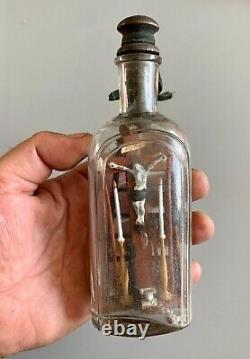
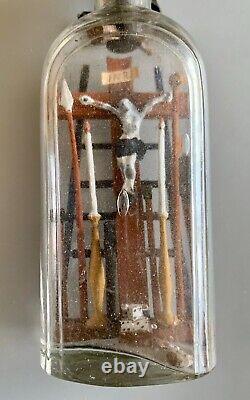
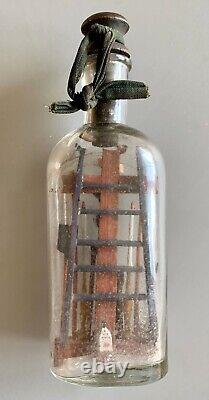
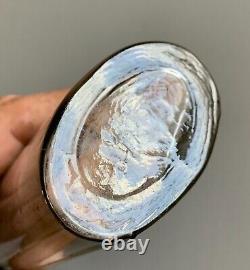
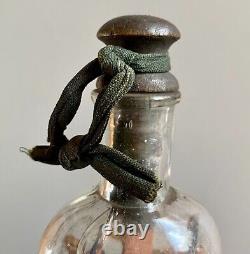


Magnificent little bottle of 19th century carved wood - folk art. The bottle of passion is a work of patience, with a miniature crucified Christ and the main instruments of the passion made of carved wood with a knife and painted, note that all elements are nested (only one is un-nested, only the rooster roams in the bottle) the cork mysteriously closed by a nail! Popular work late 19th century with traces of impurities in the very beautiful blown glass bottle, it has a sort of alcove on the front.
Height: 18 cm, 6 cm wide, thickness: only 4 cm! Miniature "Passion crosses" enclosed in glass bottles, similar to ships in bottles made by sailors: bottle of Passion, or passion bottle.
Sometimes the instruments of the Passion are simply suspended by threads inside the bottle, attached to bubble-shaped protuberances. The origin of this practice, dating back to the 18th century, is probably to be found in Liesse (Aisne) where a miraculous fountain attracted many pilgrims. Everyone left with a bottle filled with this water.They then made glass ampoules, in which they hung small figures of colored blown glass, representing two types of objects: on the one hand, the instruments of the Passion, on the other hand characters and objects related to the legend of Liesse. These vials were then filled with the miraculous water. The practice existed in Germany, in the mountains of the Allgäu and the Erzgebirge, where various scenes and passion crosses were made, under the term Geduldsflasche ("Bottle of patience").
Later this trend spread and these bottles were made everywhere, especially in Brittany where the art of putting ships in bottles already existed and in many countries up to Quebec. (source wikipedia) PASSION BOTTLE Here is a curious object of devotion that will raise at least one question: How to get all these objects through the bottleneck of the bottle when it seems logically impossible???Come on, courage and patience, all you have to do is read this article and the veil will be lifted! A Passion bottle is a transparent glass bottle, whose glass can sometimes be slightly blue or greenish and which contains a representation of the Christ on the cross called Passion of Christ or Calvary. But first, a little history. "In the year 1752, in Vienna, a religious hotel was built with its Christ on the cross, candles, vases, flowers and liturgical inscriptions. This is the first, to my knowledge, of a long series of bottles called "Passion" which represent, in addition to the episodes of the life and death of Christ, (nativity, crucifixion, deposition from the Cross.
The first French - and Breton - bottle represents a Calvary: Christ surrounded by the two thieves, equipped with all the attributes of the Passion. It bears the signature "F'rs Bazin Fecit, A St Méloir, this August 7, year 1763" (Frères Bazin, made in Saint Méloir). They are called Passion bottle, Passion bottle, Passion bottle or Calvary bottle, Calvary in a bottle and sometimes, they are found under the partially inaccurate denomination of ex-voto. A Passion bottle can only be considered as an ex-voto when it is placed in a church and only in this case.
The objects displayed in the bottle are all related to the Passion of Christ. So you can see: the cross of the Crucifixion, the nails that were used to crucify Jesus, the hammer, the tongs, the sponge with vinegar to drink at the end of the lance, cloves, fleur-de-lis, the rod of flagellation and the reed, the derisory scepter of Jesus, King of the Jews, the dice because Christ's tunic was played for dice, the centurion's lance that pierced the side of Christ, Peter's sword, the lantern of the court guards, the scepter and the whip linked to the flagellation of Jesus and the column to which he was attached for this torment, the crown of thorns, the seamless tunic, the rooster that crowed three times at Peter's denial, the ladder which is often located at the back of the cross for the hanging of the Cross, the INRI phylactery for "Jesus of Nazareth, King of the Jews", the Sacred Heart pierced by an arrow symbolizing the Passion of Christ, the skull and tibias, remains of Adam, the first man on Earth. You can also observe personal additions such as religious medals and also chromos or cut engravings representing angels or saints like the Virgin at the foot of the Cross or Saint John, ribbons, flowers and natural and dry or artificial leaves. The personalization of such a bottle was possible but not ostensible. The number of objects in the bottle varies: there may simply be the Cross with the ladder but one can also count up to 46 pieces, all related to the Passion of Christ.The objects included in the bottles are made of colored and/or gilded wood, fabric, paper or cardboard, dried plant materials, sometimes iron, plaster for small figurines and exceptionally embellished with glass beads. Some bottles are polychrome while others have raw materials. The containers are mainly bottles, carafes, flasks and jugs. Do you want to know how such a bottle is made?
Here are the tips: The first operation is to create the support that will receive the Cross. This support is itself in the shape of a cross that fits the shape of the bottom of the bottle. This ensures the stability of the upcoming structure. You can imagine that all the pieces are made outside the bottle but assembled and fixed in the bottle. The ladder is completely mounted outside the bottle, like the cross.The wood that makes it up is chosen for its flexibility: mainly birch or juniper, but also hazel. After dipping the ladder in boiling water for a while, it can bend without breaking. Carefully holding the uprights, it was then slid through the bottleneck to take its place at the back of the cross.
It quickly regains its original shape. Aubry, who restores old bottles, not believing much in this process, does it differently and here is his explanation: A ladder enters the bottle either in one piece being the width of the bottleneck, or, if wider, it is mounted inside each rung nested on one of the arms, then the other arm nested on the free ends of the rungs, all assembled by tenons and mortises. The most complex part was fixing Christ to the cross. This explains why many bottles do not contain Christ. But patience and determination can make anything possible!
The placement of the pieces in the bottle is done using long needles, punches, thin wooden picks, umbrella ribs, in short, anything long, thin and sharp that fits into the bottleneck of a bottle. Some assemblies are made with tenons and mortises and this requires great skill from the bottle maker. For many, the introduced objects are either nailed or glued. You may notice on some photos below, sometimes, the wooden cork is held by a nail or a small wooden key located horizontally and protruding from each side of the bottom of the bottleneck. It keeps the bottle closed, preventing dust from entering, while allowing moisture to escape from the bottle. The cork can swell freely, preventing the neck from breaking. More rarely, it is adorned with a dome, a crucifix, a bell tower, a head, a ball, or another religious attribute. Are the bottles typical of a region? No, not specifically, these bottles exist everywhere in France and in the world. They are found in Alsace, Auvergne, Lorraine but especially where there are patients! "However, there was in Le Puy before 1939, a real specialist working for speculative purposes. He sold his bottles for 22 francs each to the Clermont railwaymen in service on the Clermont-Le Puy line; they in turn resold them to the Limagne winegrowers." Excerpt from the book: Artisans et Paysans de France, 1946, directed by A. 236 Some can be attributed to sailors because they have two additional lanterns, essential objects for night navigation and highlighted on boats.
Such bottles exist in Quebec. They are very complete by the number of objects shown and are recognizable by the crow that sits on the crossbeam of the Cross. A thorough study of the decor allows them to be placed but solid knowledge is required.These bottles were made during long winter days and by people whose profession or occupation left them free time: sailors, military personnel or prisoners of war. They were made for themselves, as ex-votos or to be given to friends and family.
Some bottles have the particularity of containing water. This gives them a magnifying effect, making the objects inside the bottle very visible and detailed. In Auvergne, some are filled with alcohol: "This latter wood (juniper) also has the property, it seems, of giving a "good taste" and a beautiful amber color to the marc, because the bottles of "Passions", it must be said, are not only sought after for decorative purposes, but they are filled with alcohol.) " Excerpt from the book: Artisans et Paysans de France, 1946, directed by A.
